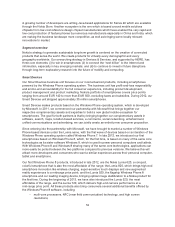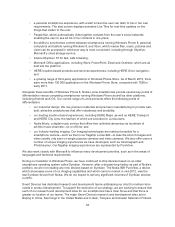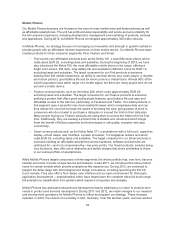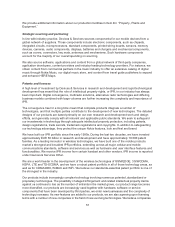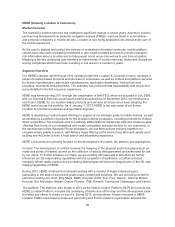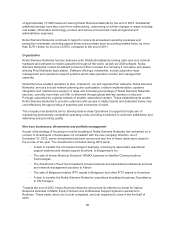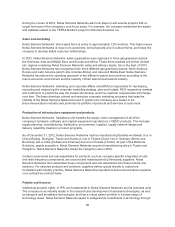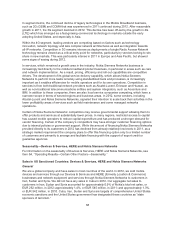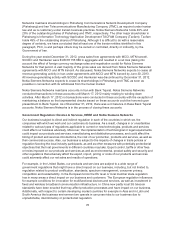Nokia 2012 Annual Report Download - page 63
Download and view the complete annual report
Please find page 63 of the 2012 Nokia annual report below. You can navigate through the pages in the report by either clicking on the pages listed below, or by using the keyword search tool below to find specific information within the annual report.1.3 million geocoded data points/second. In most cases, these vehicles are driven by geographic
researchers, each of whom is responsible for a particular geographic area which adds a critical
“human” element to our collection methodology. We also gather content from more than 80 000 other
sources, such as local governments, local transport networks, logistics companies and expert
communities.
We employ around 3 000 professional geographers. The major HERE product development sites are in
Berlin in Germany and Burlington, Cambridge and Chicago in the United States.
Patents and licenses
HERE relies primarily on a combination of copyright laws, including, in Europe, database protection
laws, trade secrets and patents to establish and protect its intellectual property rights in its database.
HERE protects its database, software and related technology through patents as well as through the
terms of license agreements and by confidentiality agreements with its employees, consultants,
customers and others.
Competition
With respect to digital map data and related location-based content, several global and local
companies, as well as governmental and quasi-governmental agencies, are making more map data
with improving coverage and content, and high quality, available free of charge or at lower prices.
Our HERE business competes with a number of participants:
• Google uses an advertising-based model allowing consumers and businesses to use its map
data and related services free of charge. Google has continued to leverage Google Maps as a
differentiator for Android, bringing certain new features and functionality to the platform.
During 2012, Google continued to invest in location content to enrich its Places offering with
the purchase of Frommer, a well-known travel guide. That followed the 2011 purchase of
Zagat, a popular restaurant guide. These acquisitions demonstrate Google’s strategy to invest
in owning and creating its own content related to Places and a move away from pure
aggregation and indexing of third-party content.
• Apple has also sought to strengthen its location assets and capabilities through targeted
acquisitions and organic growth. Apple now offers its own mapping service—based on maps
from TomTom—to its users through the latest version of iOS. Apple Maps has displaced
Google Maps, which had been pre-loaded on iOS since the iPhone’s launch in 2007, although
a web version of Google Maps—along with Nokia’s own HERE Maps—is available to iPhone
users through their browser. Apple’s pre-loaded mapping service provides iPhone users with
new map visuals such as 3D fly-over as well as free voice-guided turn-by-turn driving
directions for the first time.
• HERE also competes with companies such as TomTom, which licenses its map data and
where competition is focused on the quality of the map data and pricing, and Open Street
Map, which is a community-generated open source map available to users free of charge.
Aerial, satellite and other location-based imagery is also becoming increasingly available and
competitors are offering location-based products and services with the map data to both
business customers and consumers in order to differentiate their offerings.
We believe that economies of scale and scope in the mapping services industry favor players that are
able to provide end-to-end hardware-agnostic solutions which include proprietary content, platform (APIs)
and applications. Nokia with HERE and Google are leading examples of such players with global
footprints.
62


